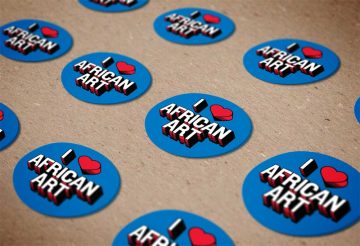Soon after the devastating Jan. 12 earthquake, first lady of Haiti Elisabeth D. Préval called on Haitian artist Philippe Dodard and his fellow artists, as well as psychologists, educators and politicians, to create a safe place for children to express their feelings through art. Nearly 100 paintings and drawings created by Haiti’s young people at Plas Timoun (The Children’s Place) are featured in “The Healing Power of Art: Works of Art by Haitian Children after the Earthquake.”
The exhibition will be on view in the concourse of the Smithsonian’s S. Dillon Ripley Center, 1100 Jefferson Drive S.W., from June 17 to Oct. 17. It is sponsored by the National Museum of African Art.
Plas Timoun operates from converted buses at two sites in Port-au-Prince and uses the power of the visual and performing arts to bring healing to children, ages 6-10. “Art, as we know, not only bears witness to the human condition but also has the power to heal,” said Johnnetta Betsch Cole, director of the National Museum of African Art. “Through this exhibition, the National Museum of African Art reinforces its connection with the Africa disapora and helps to keep Haiti in the forefront of the minds of Americans and people all over the world.”
“This exhibition gives the children of Haiti a chance to present to the world their vision of themselves and of the reconstruction of their country,” said Préval. “Their voices, so well expressed by colors and emotions, reflect our imaginary and social reality as vectors encouraging viewers to think with us of solutions to the problems facing contemporary Haiti.”
The art centers provide a friendly environment and offer children an opportunity to express themselves through painting, ceramics, music, theater, reading and sports, all within a psychosocial framework rooted in Haiti’s national culture. “The programs have a healing effect on the children’s minds as evidenced by their artworks, which have gradually moved from a gloomy to a brighter outlook,” said the first lady.
The Exhibition
Simple works on paper created immediately following the earthquake were dark in color and imagery. Soon after, drawings began to reveal glimmers of hope and healing. Most of the small works on paper and one large work on canvas featured in the exhibition use brighter colors and depict the innocence of childhood, some tempered by the tragedy but with visions for a brighter future, attesting to the resilience of a nation and the power of art. While the artworks include images relating to death and destruction, they also include illustrations of houses—both standing and damaged—with local architectural features, planes and helicopters reflecting rescue and recovery efforts, Haitian flags, as well as nature scenes and abstract designs.
In addition to the art, the exhibition includes three videos: Thirty Five Long Seconds: Haiti’s Deadly Earthquake, an 18-minute film chronicling the earthquake and its aftermath written and narrated by Mario L. Delatour, and two short video segments, one in which Dodard discusses the concept behind Plas Timoun and the other on a recent visit to Haiti by U.S. First Lady Michelle Obama and Jill Biden, wife of Vice President Joe Biden and a professor at Northern Virginia Community College. The two women traveled to Haiti in April to assess recovery and reconstruction efforts and to meet with children in several relief areas including Plas Timoun.
A free brochure will be available at the exhibition. In addition, young visitors are invited to draw a picture and send a message of hope to the children of Plas Timoun.
The exhibition is supported by the Inter-American Development Bank, Coca-Cola Co., the Sanaa Circle, Frank and Liz Blake and the Institute of Caribbean Studies in Washington, D.C. It will be open daily from 10 a.m. to 5:30 p.m. Admission is free. The Ripley Center is near the Smithsonian Metrorail station on the Blue and Orange lines.
For more information about this exhibition, call (202) 633-1000 or TTY (202) 633-5285 or visit africa.si.edu.
Folklife Festival
Haitian art and music also are featured at this year’s Smithsonian Folklife Festival (June 24-28 and July 1-5). Activities include an evening concert June 26 with Boukman Eksperyans, the
Grammy-nominated group from Haiti; craft demonstrations by painter Levoy Exil, one of the original members and best-known artists to emerge from the “Saint Soleil” school, and by artist Mireille Delisme who sews Voodoo designs that she learned from her father, an oungan (Voodoo specialist), into sequined flags; and crafts for sale in the marketplace, with 100 percent of the profit going to support the reinvigoration of traditional crafts in Haiti.
For more information about the Folklike Festival, visit www.festival.si.edu.
Smithsonian Institution-Haiti Cultural Recovery Project
In May, the Smithsonian announced it is leading a team of cultural organizations to help the Haitian government assess, recover and restore Haiti’s cultural materials damaged by the earthquake. A building in Port-au-Prince that once housed the United Nations Development Programme will be leased by the Smithsonian and serve as a temporary conservation site where objects retrieved from the ruble can be assessed, conserved and stored. It will also be the training center for Haitians who will be taking over this conservation effort in the future.
